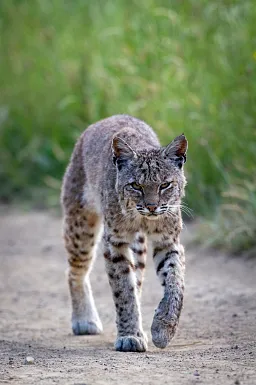Living Alongside Wild Cats

A mountain lion (puma concolor) exploring a garden on the urban edge.
Unfortunately, we often only know wild cats for being predators. But they are so much more than that! They are an important part of local ecosystems and beautiful animals.
As our urban edge expands, we move into their territory. It becomes more important for us to manage relationships with the local wildlife, including wild cats.

What does “Urban Edge” mean?
The urban edge is the area where our towns and cities meet the wilderness. These are often suburbs and housing areas!
Check out our quick reference about protecting cats at the urban edge.
Sharing The Land Responsibly With Wild Cats
If you live in a suburban area on the urban edge or in a rural area, you are probably living in proximity to wild cats. Bobcats and mountain lions (also known as pumas or cougars) are found throughout most of the US. They have deep territorial ties that cover 50–150 miles on average, so they can sometimes unknowingly venture into towns. This is especially true in towns that border wilderness and allow wildlife to venture into their streets. Mountain lions often live in low-density populations and they follow prey. So when deer, racoons, and other animals are foraging near towns, mountain lions will try to find them. Outdoor pet water bowls and sheds or other outbuildings also offer necessary cover and a water source.
When we build our towns and neighborhoods, we are building in their habitat. This is their ecosystem where their food lives. Wild cats are not inherently dangerous, but they can be if an encounter goes poorly or if they feel threatened.
This is why it is important to understand your local ecosystem and which wild cat species may be a part of it. Living in proximity with wild cats means being responsible for your relationship with them. This is their home and their territory. We need to be aware of what we are doing to encourage them to enter our neighborhoods and properties.

Tracking pumas on horseback. Part of the Patagonia Puma Project.
If you’re living in proximity with wild cats, you might encounter one out in nature, too. To stay safe during outdoor recreation, you should…
- Avoid hiking, biking or running alone, especially between dusk and dawn.
- Avoid recreating between dusk and dawn.
- If recreating alone, consider carrying pepper spray or mace. You could also use a hefty walking stick in case of a wild cat encounter.
- Keep children in front of you and close by.
- Be aware of your surroundings at all times. For example, when recreating outside, such as running or hiking, avoid wearing headphones.
- Make plenty of noise to reduce your chances of surprising a puma.
- Never approach a wild cat of any size, especially a kitten.
- Never approach a wildlife carcass.
- If you encounter a wild cat, give it a wide berth to leave the area.
Neighborhood Wild Cat Encounters
 First and foremost, stay calm. Remember: you are in their home. Wild cats are incredibly stealthy creatures and excellent hunters. If you are seeing one, they are most likely not hunting.
First and foremost, stay calm. Remember: you are in their home. Wild cats are incredibly stealthy creatures and excellent hunters. If you are seeing one, they are most likely not hunting.
They could be making themselves known because they have babies nearby and are trying to scare you away. This is typically the case if they appear actively aggressive. If they are simply making their way through, they are most likely just out for a walk. They could be checking out their territory. They could also be sick.
It’s important to remember that wild cats do not eat humans and they rarely attack without provocation. Wild cats eat a variety of animals, such as racoons, rabbits, and rodents, and deer. Deer are usually their main prey, but they will feast everything from mouse to moose. They are not inherently aggressive or violent - they only attack to hunt. Since they do not prey on humans, they will very rarely attack humans without provocation. Want to know how to act if you see one in your neighborhood? Check out our safety essentials.
You are more likely to be killed by falling plane parts than by a mountain lion. But “it is impossible to reduce the small risk to zero without eliminating either mountain lions or humans from lion habitat,” according to Paul Beier, one of North America’s premiere puma researchers.
You can report your sighting to your state and game agencies and any local wildlife organizations. We recommend this if the encounter felt very dangerous.
If you simply see one in the US, consider reporting it to the Bay Area Puma Project!
Additional Resources:

A wild bobcat in Marin County. Photo courtesy of and copyright Trish Carney. All rights reserved. Used with permission.
Protect Your Livestock From Wild Cats
To feed the human population, we have relied on livestock. People also often have hobby animals for self-sustainment, fun, and companionship.
But what does it mean for local wild cats when a ranching operation moves in?
The livestock take up land where wild cats’ natural prey used to live. So the prey population becomes limited. But the wild cats still need to eat! In their territory, they find commercial livestock or hobby animals, instead of their natural prey.
Sadly, livestock are usually less agile and slower than wild cats’ natural prey. This makes them easy pickings for a hungry wild cat. The cat will probably return to eat more! But this hurts the rancher's income, which causes them to hunt the wild cats.
The media usually only shows this kind of wild cat encounter. Society develops harsh feelings about wild cats. They forget their importance in biodiversity and only see them as a danger.
This is a vicious chain of events. It can continue until wild cats are driven extinct. This will permanently damage local ecosystems. Already, we only find mountain lions in a fraction of the lower 48 states, and the ecosystems suffer because of it!
Eradicating cats is not the answer. Ranchers and animals hobbyists can take steps to protect their animals while living in harmony with wild cats:
-
Make the property less attractive to wild cats. Wild cats' natural prey is deer and small animals. So you can use deer-resistant plants and keep animal food inside enclosures that would not attract wild animals.
-
Practice responsible livestock management. If wild cats can find their natural prey, they're less likely to attack livestock. To promote the prey population, rotate grazing areas often. This will allow for used areas to be restored. During the dry season, you can also give your livestock extra feed. If you can avoid grazing when resources are low, there will be more food for the wild cats' prey. Additionally, wild cats often prey on baby animals and newborns. To stop them from going after your babies, coordinate birthing seasons with native animals.
-
Bring free-ranging livestock into some kind of pen at nightfall. Wild cats are nocturnal and mainly hunt at night. Fully-enclosed structures have been proven most effective. But if this is not an option, other techniques improve safety.
Effective night enclosures include:
- Roofs that are sturdy enough to hold the weight of a snow load or a large wild cat, such as a mountain lion.
- An “apron” around the edge of the fence to prevent digging animals, such as coyotes, from getting in. Fencing material should be put along the ground and extended out a few feet from the fence.
- Chain link laid across the floor of the pen.
-
Have guard animals. Guard dogs, if raised and trained properly, are an effective means of preventing livestock loss through wild cat attack. The best breeds are the Anatolian Shepherd, Akbash, Great Pyrenees, and Komondor. Make sure to introduce guard dogs at a young age, around 8 weeks old, and limit their exposure to people. Work with a training professional to make sure your dog is trained properly.
-
Use motion lights and alarms. Motion-detecting lights, The Scarecrow, and The Electronic Guard are devices that can frighten wild cats away from livestock. The Scarecrow sprays cold water at the predator. The Electronic Guard uses lights and noise patterns to scare them. To stop wild cats from getting used to them, change the device up regularly.
-
Be sure to put up fencing. If you’re not able to use a covered pen, tall fences are a good option. We recommend doing this before a wild cat discovers the livestock. If a wild cat - specifically, a mountain lion - thinks of the animals as prey, it'll be harder to fend off. Mountain lions can jump up to 22 ft feet vertically, so fences should be built as high as possible. Where feasible, electric fencing is ideal, and fences should be used in combination with other deterrents, such as motion lights, voice alarms, guard dogs, and roofed enclosures for keeping animals safe at night.
We do recognize that fences are best for small pastures, but less ideal for public lands or rangelands. They're also less ideal in a place where it stops the natural movement of wildlife. To not harm local species, consider fencing a small area and calling the animals in at night. We definitely recommend this during birthing season.
We do also recommend using temporary or portable fencing. A good alternative is electric fencing, which is simple to set up and later move.
Do You Have 2-4 Hours A Month To Preserve Your Local Ecosystem?
Our volunteers are the driving force behind making true change in ecosystem health and wild cat conservation. Some like to volunteer in the field, others help us maintain our online presence, and some work with events. With just a few hours a month, you can make a difference, too.
Make A Difference Right Now
As a 501(c)3 nonprofit, our work is only possible because of generous donors like you.
More than 90% of your donation will go directly to our groundbreaking research, outreach, and education programs.
This is where true change starts. If you’d like to be a part of it, make a donation to Felidae Conservation Fund today:
Or,
